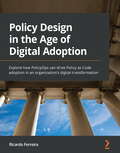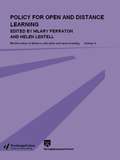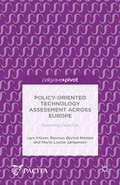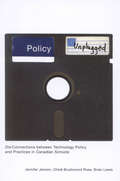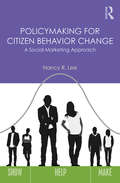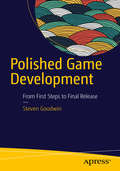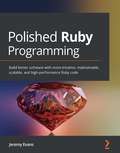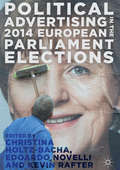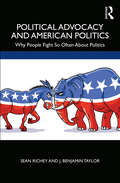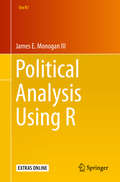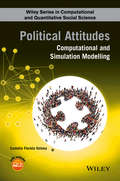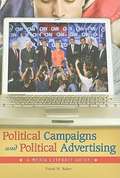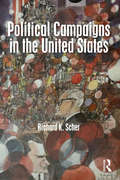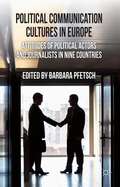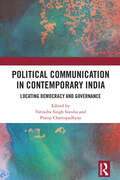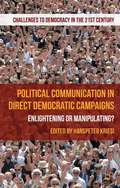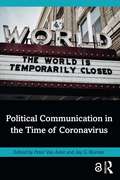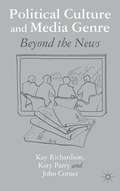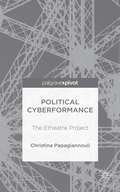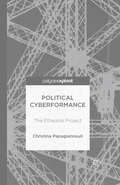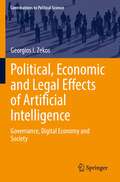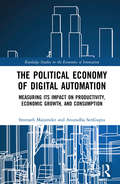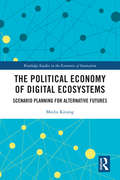- Table View
- List View
Policy Design in the Age of Digital Adoption: Explore how PolicyOps can drive Policy as Code adoption in an organization's digital transformation
by Ricardo FerreiraA proven methodology to build a PolicyOps function and public policy design frameworks for digital adoption, supporting your organization's journey into new paradigms and service models such as Cloud, SaaS, CaaS, FaaS, and DevOpsKey FeaturesUnderstand and define policies that can be consumed across the businessLeverage a framework to embed Policy as Code into the organizationLearn how to use Open Policy Agent and its powerful policy language, RegoBook DescriptionPolicy as Code (PaC) is a powerful paradigm that enables organizations to implement, validate, and measure policies at scale. Policy Design in the Age of Digital Adoption is a comprehensive guide to understanding policies, their design, and implementation for cloud environments using a DevOps-based framework. You'll discover how to create the necessary automation, its integration, and which stakeholders to involve.Complete with essential concepts, practical examples, and self-assessment questions, this book will help you understand policies and how new technologies such as cloud, microservices, and serverless leverage Policy as Code. You'll work with a custom framework to implement PaC in the organization, and advance to integrating policies, guidelines, and regulations into code to enhance the security and resilience posture of the organization. You'll also examine existing tools, evaluate them, and learn a framework to implement PaC so that technical and business teams can collaborate more effectively.By the end of this book, you'll have gained the confidence to design digital policies across your organizational environment.What you will learnUnderstand policies, guidelines, regulations and how they fit together in an organizationDiscover policy-related current challenges brought by digital transformation regarding policiesFind out about Open Policy Engine (OPA) and other policy engines for different environmentsGet to grips with the latest developments in PaC through a review of the literature, toolset, and usageExplore the PaC framework to develop trust at scale, leveraging patterns and best practicesBecome familiar with tool evaluation and selection using real-world examplesWho this book is forFrom decision-makers, such as chief information officers (CIOs) and chief information security officers (CISOs) responsible for affecting change horizontally in an organization, to cloud and DevOps architects and engineers, this book will help professionals involved in designing, implementing, and measuring policies in their organizations. A basic understanding of concepts such as cloud-native technologies, Infrastructure as Code, DevOps, and automation is necessary to get started with this book.
Policy for Open and Distance Learning: World review of distance education and open learning Volume 4
by Hilary Perraton Helen LentellPolicy for Open and Distance Learning considers the questions that planners and policy makers in open and distance learning need to address at any level of education.Starting by analysing the range of purposes for which open and distance learning is used, the book places the issues in context and examines experience in both the public and private sector. As well as discussing in detail new agenda set by new information and communication technologies, the book covers:* Inputs * Processes * Outcomes.The editors, Hilary Perraton and Helen Lentell, have drawn together an international team of contributors who have examined the varied roles of the new technologies as well as low-technology approaches to open and distance learning throughout the world.This book will be invaluable to policy makers in education and those planning or managing open and distance learning programmes. It will also be of interest to students and teachers of education and anyone concerned with comparative education.
Policy-Oriented Technology Assessment Across Europe: Expanding Capacities
by Lars Klüver Rasmus Øjvind Nielsen Marie Louise JørgensenThis book is open access under a CC-BY license. Policy-making to address grand challenges faces greater complexity than any previous project of modernization. Future scenarios are haunted by uncertainty and there is real ambivalence as to the values that policy should strive for. In this situation decision-makers look to research and innovation to provide answers and solutions. But neither can the great transitions ahead be planned by science, nor will conventional methods of innovation bring such transitions about. A turn to interactive governance is therefore underway with policy-makers and citizens becoming increasingly involved in processes of deliberating futures. Technology Assessment (TA) is the art of structuring such processes. TA goes beyond traditional expert policy analysis by systematically combining a multi-disciplinary evidence base with participatory approaches to policy deliberation. TA thus seeks to act as a hub for serious and transparent dialogue between policy, industry, science, and society about the challenges ahead and the available options for overcoming them responsibly. This volume offers an up-to-date account of the expansion of technology assessment capacities across new European member states. The contributions of this volume are written by leading European researchers and practitioners in technology assessment (TA) and are based on the PACITA (Parliaments and Civil Society in Technology Assessment) project.
Policy Unplugged
by Jennifer Jenson Chloë Brushwood Rose Brian LewisThe authors conducted a two-year study on the implementation of computer technologies, including in-depth interviews and classroom observation at thirty-two elementary and secondary schools across Canada. Based on this research, Policy Unplugged explores the intersections and disconnections between provincial technology policy, school board policy, and school-based practices. The authors consider the ways in which technology policy has become "unplugged" from daily experience, showing that teachers, students, and administrators are part of complex pedagogical and social systems that have been badly served by the enforced and hasty introduction of technology. They also show how small, often unquestioned practices and power relations in schools can create seemingly insurmountable impediments to technological implementation.
Policymaking for Citizen Behavior Change: A Social Marketing Approach
by Nancy R. LeeSocial marketing is a discipline unfamiliar to many policymakers, often confused with the more frequently applied and studied fields of social media, behavioral economics, or social change. Social marketing is a growing field and methodology, however, that has been successfully applied to improve public health, prevent injuries, protect the environment, engage communities, and improve financial well-being. Policymaking for Citizen Behavior Change is designed to demonstrate the ways in which social marketing can be an effective and efficient tool to change citizens’ behavior, and how to advocate for and support its appropriate application. Providing a 10-Step Planning Model and examining a variety of social marketing cases and tools, including more than 40 success stories, Policymaking for Citizen Behavior Change is core reading for current policymakers, as well as all those studying and practicing social marketing, particularly in the public sector. It’s also worthwhile supplementary reading for those studying public policy, public administration, environmental justice, public health, and other programs on how to effect social change.
Polished Game Development
by Steven GoodwinLearn the things you need for a complete game, such as translations and tutorials, and improve the things you've already written to raise their standard to a professional level. This is a practical guide covering every discipline: art, music, writing, and code. In the case of the latter, code examples are included to demonstrate how to implement functionality to make the game shine. Polished Game Development acts as a comprehensive checklist of everything your game should, and should not, do, in order to be as good as it possibly can. It is more than just a book on theoretical game design principles. Explains the difference between a pet project, and a professional one. Covers how to test for the problems and bugs you don't know you'll have. Details simple, but effective, visual improvements that can be done with very little effort. Regardless of platform (web, mobile, or console), or language (C++, C#, JavaScript) there is a wealth of common (and specific) tips within these pages that will enable you to make the most professional games you can. What You Will LearnLearn what essential elements are often missedStay on-brand, visually and verballyUse audio to enhance your gameImprove game balanceTest effectivelyWho This Book Is ForPolished Game Development is for game developers looking for a guide and checklist on how to get their game finished to the highest possible standards. They will know how to write a game, and get it released, but not necessarily how to make it shine. They will be professional developers, indies, university students and graduates.
Polished Ruby Programming: Build better software with more intuitive, maintainable, scalable, and high-performance Ruby code
by Jeremy EvansBecome an accomplished Ruby programmer by understanding the design principles, best practices, and trade-offs involved in implementation approaches to keep your Ruby applications maintainable in the long termKey FeaturesUnderstand the design principles behind polished Ruby code and trade-offs between implementation approachesUse metaprogramming and DSLs to reduce the amount of code needed without decreasing maintainabilityLearn Ruby web application design principles and strategies for databases, security, and testingBook DescriptionMost successful Ruby applications become difficult to maintain over time as the codebase grows in size. Polished Ruby Programming provides you with recommendations and advice for designing Ruby programs that are easy to maintain in the long term. This book takes you through implementation approaches for many common programming situations, the trade-offs inherent in each approach, and why you may choose to use different approaches in different situations. You'll start by learning fundamental Ruby programming principles, such as correctly using core classes, class and method design, variable usage, error handling, and code formatting. Moving on, you'll learn higher-level programming principles, such as library design, use of metaprogramming and domain-specific languages, and refactoring. Finally, you'll learn principles specific to web application development, such as how to choose a database and web framework, and how to use advanced security features. By the end of this Ruby programming book, you'll have gained the skills you need to design robust, high-performance, scalable, and maintainable Ruby applications. While most code examples and principles discussed in the book apply to all Ruby versions, some examples and principles are specific to Ruby 3.0, the latest release at the time of publication.What you will learnUse Ruby's core classes and design custom classes effectivelyExplore the principles behind variable usage and method argument choiceImplement advanced error handling approaches such as exponential backoffDesign extensible libraries and plugin systems in RubyUse metaprogramming and DSLs to avoid code redundancyImplement different approaches to testing and understand their trade-offsDiscover design patterns, refactoring, and optimization with RubyExplore database design principles and advanced web app securityWho this book is forIf you already know how to program in Ruby and want to learn more about the principles and best practices behind writing maintainable, scalable, optimized, and well-structured Ruby code, then this Ruby book is for you. Intermediate to advanced-level working knowledge of the Ruby programming language is expected to get the most out of this book.
Political Advertising in the 2014 European Parliament Elections
by Christina Holtz-Bacha Edoardo Novelli Kevin RafterThis timely publication offers a fresh scholarly assessment of political advertising across the EU, as well as an insight into differing political and regulatory systems related to political advertising in the individual member states. With a detailed focus on the images and communication styles that characterised the 2014 European Parliament election campaign, this edited collection evaluates political advertising across the EU using empirical data to compare and contrast styles and approaches in different members. This work allows the authors to offer an important evaluation of the similarities and differences in the posters and broadcasts used to win public support in the 2014 campaign at the time of the great European recession and financial crisis, specifically looking at the place of posters and video commercials. This book will appeal to researchers and students of political communication, political science, history, European studies as well as candidates and campaign workers who want a more comprehensive understanding of the representation of Europe in political adverts at the 2014 elections.
Political Advertising in the United States
by Michael M. Franz Travis N. Ridout Erika Franklin FowlerPolitical Advertising in the United States examines the volume, distribution, content, and effects of political advertising in congressional and presidential elections. The book considers the role of television ads using extensive data on ad airings on local broadcast stations. It also analyzes newly available data on paid digital ads, including ads on Facebook, Instagram, Google, and YouTube. The book covers the role of outside groups in airing ads, including the rise of dark money groups and gaps in existing federal campaign finance laws around transparency of outside group spending. The authors consider how ad sponsors design and target ads. They also review the positive and negative implications of an electoral system where billions are spent on paid advertising. With detailed analysis of presidential and congressional campaign ads and discussion questions in each chapter, this accessibly written book is a must-read for students, scholars, and practitioners who want to understand the ins and outs of political advertising. New to the Second Edition • Covers the spending, content, and tone of political advertising in the 2016 and 2020 presidential elections and the 2018 midterms, looking ahead to 2022 and 2024. • Addresses the interference of foreign actors in elections and their connection to political advertising. • Expands the discussion of digital political advertising and incorporates this topic into every chapter. • Adds a new chapter specifically addressing digital ad content and spending. • Includes data from the Facebook, Google, and Snapchat ad libraries and explores the role of these companies in regulating the sale of political advertising. • Incorporates new data on the effects of race and gender in advertising, including what is known about the way in which advertising may activate prejudicial attitudes.
Political Advocacy and American Politics: Why People Fight So Often About Politics
by Sean Richey J. Benjamin TaylorPolitical Advocacy and American Politics provides a detailed explanation as to why citizens engage in interpersonal advocacy in the United States. Sean Richey and J. Benjamin Taylor eloquently show how the campaigns, social media, and personality and partisanship affect one's propensity for candidates, which often leads to arguments about politics. Using original qualitative, survey, and experimental studies, Richey and Taylor demonstrate the causes of political advocacy over time in the political environment and at the individual level. While some worry about the incivility in American politics, Richey and Taylor argue political talk, where conflict is common, is caused by high-activity democratic processes and normatively beneficial individual attributes. Furthermore, Richey and Taylor argue that advocacy—when conceptualized as a democratic "release valve"—is exactly the kind of conflict we might expect in a vibrant democracy. Political Advocacy and American Politics: Why People Fight So Often About Politics is ideal for university students and researchers, yet it is also accessible to any reader looking to learn more about the role campaigns and personal attributes play in the decision to advocate.
Political Analysis Using R
by James E. MonoganThis book provides a narrative of how R can be useful in the analysis of public administration, public policy, and political science data specifically, in addition to the social sciences more broadly. It can serve as a textbook and reference manual for students and independent researchers who wish to use R for the first time or broaden their skill set with the program. While the book uses data drawn from political science, public administration, and policy analyses, it is written so that students and researchers in other fields should find it accessible and useful as well. By the end of the first seven chapters, an entry-level user should be well acquainted with how to use R as a traditional econometric software program. The remaining four chapters will begin to introduce the user to advanced techniques that R offers but many other programs do not make available such as how to use contributed libraries or write programs in R. The book details how to perform nearly every task routinely associated with statistical modeling: descriptive statistics, basic inferences, estimating common models, and conducting regression diagnostics. For the intermediate or advanced reader, the book aims to open up the wide array of sophisticated methods options that R makes freely available. It illustrates how user-created libraries can be installed and used in real data analysis, focusing on a handful of libraries that have been particularly prominent in political science. The last two chapters illustrate how the user can conduct linear algebra in R and create simple programs. A key point in these chapters will be that such actions are substantially easier in R than in many other programs, so advanced techniques are more accessible in R, which will appeal to scholars and policy researchers who already conduct extensive data analysis. Additionally, the book should draw the attention of students and teachers of quantitative methods in the political disciplines.
Political Attitudes: Computational and Simulation Modeling
by Camelia F. VoineaPolitical Attitudes: Computational and Simulation Modeling Camelia Florela Voinea, Department of Political Science, International Relations and Security Studies, University of Bucharest, Bucharest, Romania Political Science has traditionally employed empirical research and analytical resources to understand, explain and predict political phenomena. One of the long-standing criticisms against empirical modeling targets the static perspective provided by the model-invariant paradigm. In political science research, this issue has a particular relevance since political phenomena prove sophisticated degrees of context-dependency whose complexity could be hardly captured by traditional approaches. To cope with the complexity challenge, a new modeling paradigm was needed. This book is concerned with this challenge. Moreover, the book aims to reveal the power of computational modeling of political attitudes to reinforce the political methodology in facing two fundamental challenges: political culture modeling and polity modeling. The book argues that an artificial polity model as a powerful research instrument could hardly be effective without the political attitude and, by extension, the political culture computational and simulation modeling theory, experiments and practice. This book: Summarizes the state of the art in computational modeling of political attitudes, with illustrations and examples featured throughout. Explores the different approaches to computational modeling and how the complexity requirements of political science should determine the direction of research and evaluation methods. Addresses the newly emerging discipline of computational political science. Discusses modeling paradigms, agent-based modeling and simulation, and complexity-based modeling. Discusses model classes in the fundamental areas of voting behavior and decision-making, collective action, ideology and partisanship, emergence of social uprisings and civil conflict, international relations, allocation of public resources, polity and institutional function, operation, development and reform, political attitude formation and change in democratic societies. This book is ideal for students who need a conceptual and operational description of the political attitude computational modeling phases, goals and outcomes in order to understand how political attitudes could be computationally modeled and simulated. Researchers, Governmental and international policy experts will also benefit from this book.
Political Campaigns and Political Advertising: A Media Literacy Guide
by Frank W. BakerBaker, a media literacy consultant and author, has written this media literacy guide for general readers who want more critical insight into propaganda and spin, political advertising and the role of new media technologies in election campaigns. The author uses clear and easy-to-understand language to examine and interpret the content of media messages in print, image and multimedia forms in an objective manner. The author supplies both a timeline of the history of media in politics from 1913 to the present and a glossary of political and media terms. Annotation ©2009 Book News, Inc., Portland, OR (booknews.com)
Political Campaigns in the United States
by Richard K. ScherA Choice Highly Recommended Title—January 2017 This book is an interpretive analysis of political campaigns in America: instead of focusing on how campaigns are designed and run, it investigates the role campaigns play in our American politics, and the close symbiosis between campaigns and those politics. The text examines how campaigns are an important manifestation of how we "do" politics in this country. Hallmarks of this text include: showing how campaigns can undermine our democracy and asking how democratic they—and by extension, our politics--really are; demonstrating that the ability of the media to accurately, fairly, and deeply report on campaigns has been severely compromised, both because of the growing "distance" between campaigns and media outlets and because of the structure of "Big Media" corporate ownership and its tight relationship to "Big Money." It asks important questions about the media including: How do the media, reporters in particular, cover campaigns? What pressures and forces shape what and how they present campaigns? What is the impact of the ever-increasing chasm separating campaigns and the media? How does the close tie between corporate mainstream media and Super PAC money affect campaign coverage? How does the ability of campaigns and media to segment voters into ever-smaller slices influence how campaigns are covered? tracking the continuing growth of unregulated, private, unaccountable "dark money" in campaigns as a threat to our democratic elections and politics. Democracy rests fundamentally on transparency and accountability – sunlight – and our campaign laws and norms now allow and encourage exactly the opposite, largely because of decisions by the United States Supreme Court.
Political Communication Cultures in Europe
by Barbara PfetschThis book offers new and compelling insight into the orientations that shape the cultures of political communication in nine Western democracies. It is a truly comparative account of the views of 2500 political elites and media elites between Helsinki and Madrid on their relationship and their exchanges.
Political Communication in Contemporary India: Locating Democracy and Governance
by Yatindra Singh Sisodia Pratip ChattopadhyayThis book explores the forms, patterns, and trends in political communication in India in the twenty-first century. It underlies the influence of context in political messaging laying bare its complex, overlapping, and multidimensional structures. The volume: Examines how political decision-making is shaped by media — through political speeches, community opinion leaders, and formal and informal public conversations. Explores a range of political communication channels— from community radio to social media. Presents an overview of the problems associated with message designing and message dissemination through communication channels in a political setting. Highlights how political communication impacts critical aspects of democracy and governance and goes beyond mere rhetoric. A comprehensive work on the production, diffusion, transmission, and impact of information in a political environment, this book will be of great interest to scholars and researchers of politics, governance, democracy, media and communication studies, journalism, cultural studies, and South Asian studies.
Political Communication in Direct Democratic Campaigns
by Hanspeter KriesiAnalyzes the communication processes in direct democratic campaigns and their effect on the opinion formation of the voters. Based on a detailed analysis of the politicians' strategies, media coverage and the opinion formation of the public in three campaigns, this book argues that the campaigns are more enlightening than manipulating.
Political Communication in Postmodern Democracy
by Kees Brants Katrin VoltmerThis book explores the changing relationship between politics, the media and citizens. Based on comparative evidence from the UK and the Netherlands it provides new insights into the dynamics of political communication in post-modern democracy, which is characterized by uncertainty about the location of politics and an erosion of grand narratives and political ideologies. The contributions of this volume aim to understand these changes as a two-dimensional process: the horizontal dimension encompasses the shifting power balance between politicians and the media. The vertical dimension explores how new forms of citizenship and the pervasiveness of popular culture alongside new communication technologies are challenging the authority of both established journalism and institutionalized politics. What emerges is a complex picture of politicization and de-politicization, elite dominance and the power of vox populi, mediatisation and effective control of political elites over the public agenda.
Political Communication in the Time of Coronavirus
by Peter Van AelstThis book examines how the COVID-19 pandemic impacted the flows of communication between politicians, journalists, and citizens. Distinguished contributors grapple with how the pandemic, as a global unexpected event, disrupted the communication process and changed the relationships between politics, media, and publics, the three central players of political communication. Using different methodologies, they scrutinize changes in government communication, (new) media coverage, and public opinion during this crisis. The book moves beyond the USA and Western Europe to include cases from Eastern Europe, Latin America, and Asia, taking into account how variations in the political context, the media system and personal leadership can influence how the COVID-19 pandemic challenged the political communication process. It is an ideal text for advanced students and scholars of political communication, political science, and media studies.
Political Culture and Media Genre
by Kay Richardson Katy Parry John CornerExploring the forms and meanings of mediated politics beyond the news cycle, this book encompasses genres drawn from television, radio, the press and the internet, assessing their individual and collective contribution to contemporary political culture through textual analysis and thematic review.
Political Cyberformance: The Etheatre Project
by Christina PapagiannouliWritten from a practice-based perspective, this book focuses on the political character of 'cyberformance': the genre of digital performance that uses the Internet as a performance space. The Etheatre Project comprises a series of experimental cyberformances aiming to reconsider the characteristics of theatre in the Internet age.
Political, Economic and Legal Effects of Artificial Intelligence: Governance, Digital Economy and Society (Contributions to Political Science)
by Georgios I. ZekosThis book presents a comprehensive analysis of the alterations and problems caused by new technologies in all fields of politics. It further examines the impact of artificial intelligence (AI) on the nexus between politics, economics, and law. The book raises and answers several important questions: What is the role of AI in politics? Are people prepared for the challenges presented by technical developments? How will Al affect future politics and human society? How can politics and law deal with Al's disruptive technologies? What impact will AI and technology have on law? How can efficient cooperation between human beings and AI be shaped? Can artificial intelligence automate public decision-making?Topics discussed in the book include, but are not limited to digital governance, public administration, digital economy, corruption, democracy and voting, legal singularity, separation of power, constitutional rights, GDPR in politics, AI personhood, digital politics, cyberspace sovereignty, cyberspace transactions, and human rights. This book is a must-read for scholars and students of political science, law, and economics, as well as policy-makers and practitioners, interested in a better understanding of political, legal, and economic aspects and issues of AI.
The Political Economy of Digital Automation: Measuring its Impact on Productivity, Economic Growth, and Consumption (Routledge Studies in the Economics of Innovation)
by Sreenath Majumder Anuradha SenGuptaWith digital automation becoming ubiquitous, the relationship between man and machine is being redefined. This book, through a focus on America, identifies the tension this relationship has produced, and how it has divided America socially, politically, and economically, ultimately breeding two fundamentally incompatible nations within one: the “forgotten America” and “elite America.” This book enables the reader to visualize the changes brought by automation on our producer and buyer identities, and suggests policy changes that global leaders could adopt to deal with the increasing discord. The book is heavily dependent on a few fundamental concepts of both economics and sociology, such as globalization, labor economics, and cultural homogenization. The book is ideally suited to students and academics researching political economics and sociology, with focuses on globalization, unemployment, and the social impacts of technological advances.
The Political Economy of Digital Ecosystems: Scenario Planning for Alternative Futures (Routledge Studies in the Economics of Innovation)
by Meelis KitsingThis book connects political economy perspectives with scenario planning for mapping out future trajectories of digital ecosystems. The focus is purposefully on digital ecosystems as it encompasses economic, political and social contexts on a global, national and local level. The diversity of political economy approaches allows the author to explore alternative meanings of digital ecosystem development, which is particularly useful for envisioning alternative futures. Often visions about the future of digital ecosystems suffer from a lack of imagination and confirmation bias which is favorable to the extrapolation of current trends. A wide range of political economy perspectives applied through positivist theorizing in this book shows different interpretations of developments in digital ecosystems. Scenario planning teams around the world have applied a collective imagination to show how future trajectories can be radically different from the current trends. The book outlines meta-scenarios for alternative futures of the political economy of digital ecosystems by reviewing and synthesizing the work of foresight teams. These meta-scenarios served as insights for developing four scenarios for European digital ecosystems through the workshops with high-level executives and experts. The scenarios identified the nature of EU cooperation and the development of digital infrastructure as key drivers. These four scenarios developed in the workshops are further operationalized in a specific context by exploring the implications for Estonia as well as for Chinese investments in European platforms. This exercise shows how scenarios of digital ecosystems can be used for stress-testing decisions and strategies. Decision-makers, students, scholars and other stakeholders in a wide range of industries ranging from academia to ride-sharing can use the scenarios for reframing different development trajectories and future-proofing their strategies. The scenarios can be further developed and modified for specific purposes and contexts as they are not written in stone.
